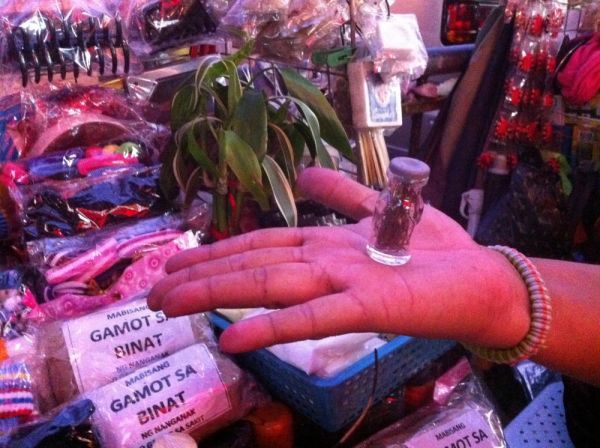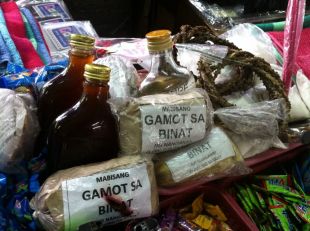Mixing Science and Faith, Herbal Medicine Markets Offer Cures and Jobs

Even in this day and age, informal vendors of herbal remedies find a steady stream of customers. Photo credit: Purple Romero
Rosemary opens a small bottle, pulls out a tiny root and wets it with her saliva. “Look, this is real.” She motions to the root as we watch it move seconds after she spreads her spit on it.
Rosemary says this is how her customers know that her product – a bottle of roots that includes a spell written on a small piece of paper – actually works. It’s a love potion that she sells for $2 USD, mostly to women and gay men. She says she tested the potion on her own friend whose husband had stopped talking to her for more than a year while he worked abroad. After a week of using the love potion, says Rosemary, the husband suddenly called home.
Rosemary’s potion is just one of many herbal medicines, ointments and rocks that she claims can rectify virtually any of life’s problems, from the personal to the medical. We’re at a marketplace in Quiapo, an area in Manila best known for its annual Feast of Nazarene, where hundreds of thousands of people flock to the Quiapo Church to touch the black statue of Jesus Christ.
One needs faith to fervently believe that touching the wooden sculpture will affect change – and many here have it, just as they have faith in the herbs and concoctions being sold by Rosemary. Even in modern Manila, informal markets selling herbal remedies are extremely popular. There are 100 stalls around Quiapo selling herbal medicines, most of them found at the back of the Quiapo Church. They are located beside stalls that sell pirated DVDs, sex toys, religious figurines and street food. Most of Rosemary’s customers are housewives who she says are trying to find cheaper medicines for their kids, but her clientele spans all walks of life.

Vendors say they may not understand the science behind their remedies, but they say they know they work. Photo credit: Purple Romero
Iya (not her real name), a preschool teacher, says she starting buying herbal remedies from Quiapo after the other medications prescribed by her dermatologist failed to cure her acne. She reasons that there’s no harm in trying, and adds that she went to Quiapo after she consulted a faith healer who said her acne may have been caused not by dirt or pollution, but witchcraft.
Another vendor, Vangie Paa, complains about doctors warning the public that buying herbal medicines at informal markets is unsafe. But some of the herbs being sold in Quiapo do have medicinal value, according to Rustico Jimenez, president of the Private Hospitals Association of the Philippines. He cites pito-pito, for instance, which in English means 7-7, the number of leaves or seeds mixed together to form a decoction – for example, 7 leaves from the plants alagaw, banaba, guava, pandan and mango.
Jimenez says that at PHAP, a formal organization recognized by the government, they recommend their patients use pito-pito. Pito-pito fetches less than a dollar at the market in Quiapo for its supposed ability to help cure headaches, fever, coughs and colds. Banaba, a diuretic that eases the flow of urine, also costs less than a dollar per pack.
Informal markets like this one allow vendors to eke out an existence. Meanwhile, the Philippines’ formal pharmaceutical industry is cashing in on the country’s strong faith in herbal remedies. Engineer Higinio Porte Jr., director of plant operations at Pascual Laboratories, says his company works with the government to develop herbal medicines for mass production. He says Pascual got its production technology from the governmental Department of Science and Technology, and the DOST-Philippine Council for Health and Development has offered assistance in herbal research and development to pharmaceutical firms. The Department of Health, in fact, started promoting the use of herbal medicines in 1995 under the term of then-DOH Sec. Juan Flavier. And though the DOH recognizes only 10 herbal medicines, such remedies now represent a 2 billion peso industry in the Philippines.
Those who sell at the market in Quiapo see hardly a pinch of those earnings, however. Paa and Rosemary earn about $10 to $17 USD a day, and they’ve been vending here for more than 20 years. Paa took over the family business of selling herbal medicines from her mother when she was in high school. Neither one of them ever went to college.
They’re not familiar with the huge formal herbal-medicine industry in their country, nor the opportunities from DOST that they could take advantage of, such as research assistance and training on related technology. And even if they were, Paa and Rosemary say they are reluctant to undergo any process that would formalize what they do. Paa adds that even if she wanted to, she couldn’t apply for a job at a drug company because of her lack of education.
Many of the vendors in Quiapo, in fact, can hardly tell you the official names of their plants and herbs. Paa says the ones she received today were delivered from Visayas, a region to the south of Manila; the cure for those who were victimized by witchcraft came from the northern part of Luzon, while the love potions were given to her by a faith healer from Visayas.
But she insists that her business isn’t a scam. She may not know the scientific terms for what she sells, she says, but 20 years have taught her what works. And she swears by the safety of her product – indeed, when her own kids get sick, this is what she gives them. “I boil them and let them drink the tea,” she says. And if a customer complains that what they bought didn’t work, she tells them, “You need to have more faith.”









